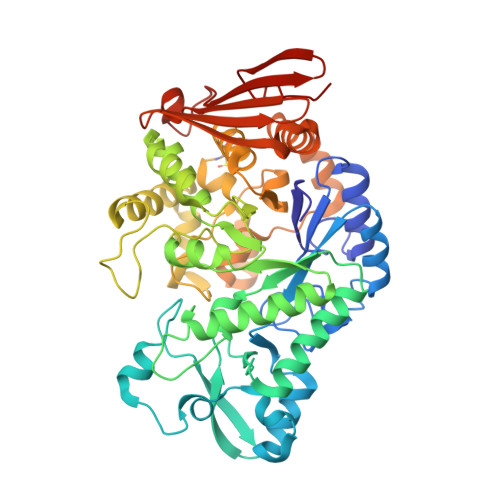Structural Rearrangements of Sucrose Phosphorylase from Bifidobacterium adolescentis during Sucrose Conversion
Mirza, O., Skov, L.K., Sprogoe, D., van den Broek, L.A.M., Beldman, G., Kastrup, J.S., Gajhede, M.(2006) J Biol Chem 281: 35576-35584
- PubMed: 16990265
- DOI: https://doi.org/10.1074/jbc.M605611200
- Primary Citation of Related Structures:
2GDU - PubMed Abstract:
The reaction mechanism of sucrose phosphorylase from Bifidobacterium adolescentis (BiSP) was studied by site-directed mutagenesis and x-ray crystallography. An inactive mutant of BiSP (E232Q) was co-crystallized with sucrose. The structure revealed a substrate-binding mode comparable with that seen in other related sucrose-acting enzymes. Wild-type BiSP was also crystallized in the presence of sucrose. In the dimeric structure, a covalent glucosyl intermediate was formed in one molecule of the BiSP dimer, and after hydrolysis of the glucosyl intermediate, a beta-D-glucose product complex was formed in the other molecule. Although the overall structure of the BiSP-glucosyl intermediate complex is similar to that of the BiSP(E232Q)-sucrose complex, the glucose complex discloses major differences in loop conformations. Two loops (residues 336-344 and 132-137) in the proximity of the active site move up to 16 and 4 A, respectively. On the basis of these findings, we have suggested a reaction cycle that takes into account the large movements in the active-site entrance loops.
Organizational Affiliation:
Biostructural Research Unit, Department of Medicinal Chemistry, Danish University of Pharmaceutical Sciences, Universitetsparken 2, DK-2100 Copenhagen, Denmark.

















